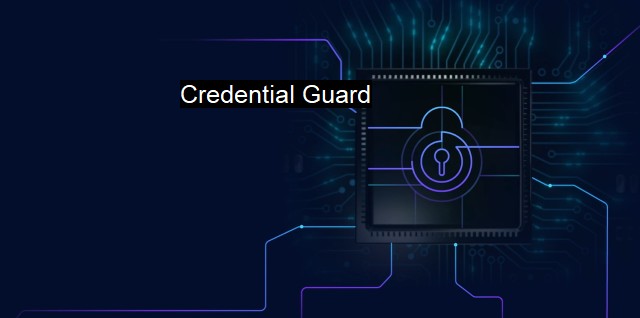What is Credential Guard?
Understanding Credential Guard: Bolstering Cybersecurity Measures for Enhanced Protection of Sensitive Data in Evolving Technological Landscapes
"Credential Guard" is an advanced feature primarily available in Windows 10 enterprise that evolves the approach to how sensitive security data like credentials is stored in a Windows environment, transitioning from the isolated module of the kernel into a hardware-based secure execution environment known as a Virtual Secure Mode (VSM). The main objective of Credential Guard is to leverage robust hardware security features to shield, or more accurately, guard, sensitive information present in the system against potential threats.In the realm of cybersecurity and antivirus protection, the addition of Credential Guard has made the combat against attackers more effective. Historically, one of the primary targets in cybersecurity breaches has been credentials. Whether for single-user or privileged accounts, cybercriminals quite frequently try to sneak out secret credentials to gain unauthorized access, extract information, disrupt system functionalities, or deliver malware. By allowing users to isolate and protect NTLM password hashes and Kerberos Ticket Granting Tickets, Credential Guard fights off such attacks effectively, making it a key player in maintaining the integrity of cybersecurity.
To comprehend how Credential Guard operates, it’s beneficial to understand how essential credentials are susceptible to various cyberattack techniques. One such methods is "Pass-the-Hash" attack. In this type of attack, attackers need not know the user's plain text password. They identify and extract the stored password hash and use it for unauthorized access, hence the term “pass-the-hash” is applied. Hence, without robust measures to protect these hashes, an entire data system could be at risk.
Credential Guard utilizes advanced security features like virtualization and provisioning of secured environments to resist such attacks. These are achieved through a combination of hardware and software security features. It operates by isolating secrets in a hardware-supported virtual machine, leveraging advanced attributes like virtualization-based security and Secure Boot.
To ensure data security, Credential Guard uses two processes – Local Security Authority (LSA) and Isolated LSA (LSAIso). In practical terms, it means two LSA processes exist at the same time; one with full credentials and one with limited privileges. LSAIso, being the process running in the VSM, handles encrypted credential material. LSA processes outside the VSM do not have direct access to the sensitive data.
With the usage of Direct Memory Access (DMA) protection, Credential Guard safeguards data even if an intruder has gained physical access to the PC. DMA protection prohibits external peripherals from accessing the user's internal memory of their device unless authenticated.
Credential Guard, through its in-built integrity measurement architecture and features like the Early Launch Anti-Malware (ELAM) part of system start-up, ensures that only properly signed and authorized system components can operate in the system environment. Indeed, by functioning hand-in-hand with security products offering antivirus protection, it helps to present a robust shield against orchestrated cyberattacks and malware intrusions.
While Credential Guard enhances system security, it may also require consideration in design stages as not all systems and hardware can support the virtualization features it requires. Implementing Credential Guard warrants careful infrastructure examination and appropriate resource planning. concerning high-stakes cybersecurity and antivirus protection, the benefits undoubtedly outweigh potential complications, therein driving the case for comprehensive solutions providers to integrate Credential Guard capabilities in their offering.
Credential Guard is an innovative tool in the fight against cyber attacks, providing a barrier that can effectively deter and protect against credential theft. It uses enhanced security features such as virtualization and secured environments to protect user credentials and fight off potential attacks. Credentials are a prime target for cybercriminals, and by safeguarding them, Credential Guard contributes significantly towards enhancing cybersecurity mechanisms.

Credential Guard FAQs
What is Credential Guard?
Credential Guard is a security feature in Windows 10 and Windows Server 2016 that helps protect user credentials from being stolen or compromised by malicious software.How does Credential Guard work?
Credential Guard uses virtualization-based security to isolate sensitive data, such as login credentials, from the rest of the operating system. It creates isolated containers called security containers that store user secrets and only allow authorized processes to access them.What are the benefits of using Credential Guard?
Credential Guard provides an additional layer of security to help protect against advanced cyber attacks, such as Pass-the-Hash, where an attacker steals and reuses a network user’s credentials to gain access to systems and data. It also helps protect against malware that attempts to steal user credentials or harvest them from memory.Do I need to have a specific hardware to use Credential Guard?
Yes, you need to have a computer with a processor that supports virtualization and the ability to enable virtualization-based security in the BIOS. If your computer does not meet these requirements, you will not be able to use Credential Guard.| | A | | | B | | | C | | | D | | | E | | | F | | | G | | | H | | | I | | | J | | | K | | | L | | | M | |
| | N | | | O | | | P | | | Q | | | R | | | S | | | T | | | U | | | V | | | W | | | X | | | Y | | | Z | |
| | 1 | | | 2 | | | 3 | | | 4 | | | 7 | | | 8 | | |||||||